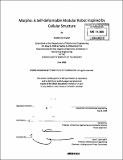Morpho : a self-deformable modular robot inspired by cellular structure
Author(s)
Haller, Kristina M. (Kristina Marie)
DownloadFull printable version (6.113Mb)
Alternative title
Self-deformable modular robot inspired by cellular structure
Other Contributors
Massachusetts Institute of Technology. Dept. of Mechanical Engineering.
Advisor
Daniela Rus.
Terms of use
Metadata
Show full item recordAbstract
In this paper, we present a modular robot design inspired by the creation of complex structures and functions in biology via deformation. Our design is based on the Tensegrity model of cellular structure, where active filaments within the cell contract and expand to control individual cell shape, and sheets of such cells undergo large-scale shape change through the cooperative action of connected cells. Such deformations play a role in many processes: early embryo shape change, heart and intestine function, and in lamprey locomotion. Modular robotic systems that replicate the basic deformable multicellular structure have the potential to quickly generate large-scale shape change and create time-varying shapes to achieve different global functions. We present a design and initial hardware implementation of this model. Our design includes four different modular components: (1) actuating links, (2) passive (compressive) links, (3) elastic surface membranes, and (4) universal connecting interfaces. In both hardware implementation and simulation, we show several self-deformable structures that can be generated from these four components, including the deformable surface, expandable cube, terrain-adaptive bridge from [1] and some examples inspired by biology. We argue that self-deformation is more appropriate for dynamic and sensing-adaptive shape change in a certain class of tasks.
Description
Thesis (S.B.)--Massachusetts Institute of Technology, Dept. of Mechanical Engineering, 2008. Includes bibliographical references (leaves 15-16).
Date issued
2008Department
Massachusetts Institute of Technology. Department of Mechanical EngineeringPublisher
Massachusetts Institute of Technology
Keywords
Mechanical Engineering.